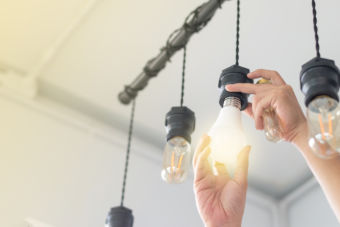Energy Savings: Good, Better, Best
 We all know to turn lights off when we’re not using them. But newer technologies mean now you can save a lot more – and change bulbs a lot less – just by choosing the right light.
We all know to turn lights off when we’re not using them. But newer technologies mean now you can save a lot more – and change bulbs a lot less – just by choosing the right light.
Federal energy-efficiency standards fully phased out inefficient general service incandescent light bulbs in 2014.
Your choices now, from good to best, are:
- Good: Halogen incandescents
- Better: CFL lighting (compact fluorescent lamp)
- Best: LED lighting
All use at least 25% less energy. LEDs (light-emitting diodes) use up to 85% less. Compare your options, think about which lights would be best for each room and task, and start saving!
LED Lighting
If every American swapped just one lightbulb for an ENERGY STAR® labeled LED bulb, it would collectively save more than $8 billion in energy costs and remove 2 million cars worth of greenhouse gas emissions from our atmosphere.
What is LED lighting?
- LED stands for light-emitting diode.
- LED lighting uses much less energy than incandescent bulbs and can last for decades.
- LED lighting doesn’t contain any mercury, which makes disposal easy.
Why Switch?
- LED lighting saves money! The less energy it takes to light your house, the lower your electric bill will be. That’s why it’s a good idea to replace the lights you use most often with LED lighting options.
- LED lighting lasts far longer than standard bulbs. That makes it an excellent choice for lighting in hard-to-reach areas.
- LED lighting produces good light and the same amount of light as incandescent bulbs while using significantly less energy.
- LED lighting helps fight global warming. It uses at least 2/3 less energy than standard bulbs to produce the same amount of light. When you use less energy, that means less energy must be generated by coal or natural gas-fired power plants, which creates pollution that leads to global warming.
Think Lumens Instead of Watts
When you need a replacement for a standard incandescent light bulb, compare lumens (brightness). The higher the lumens, the brighter the light. A 60-watt standard incandescent produces about 800 lumens. You can get the same amount of light from a 10-watt LED.
Light Appearance: Warm or Cool?
If you want a light that looks like a standard incandescent, choose warm light. You can buy all three bulb types in warm tones, while CFL and LED options are also available in cool light. Some LEDs even allow you to adjust between warm and cool.
Check the Lighting Facts Label
To make comparisons easier, lighting packages now include Lighting Facts labels — which look like nutrition labels — that show brightness (lumens), estimated yearly energy cost (dollars), life (years), light appearance (from “warm” to “cool”) and energy used (watts).
